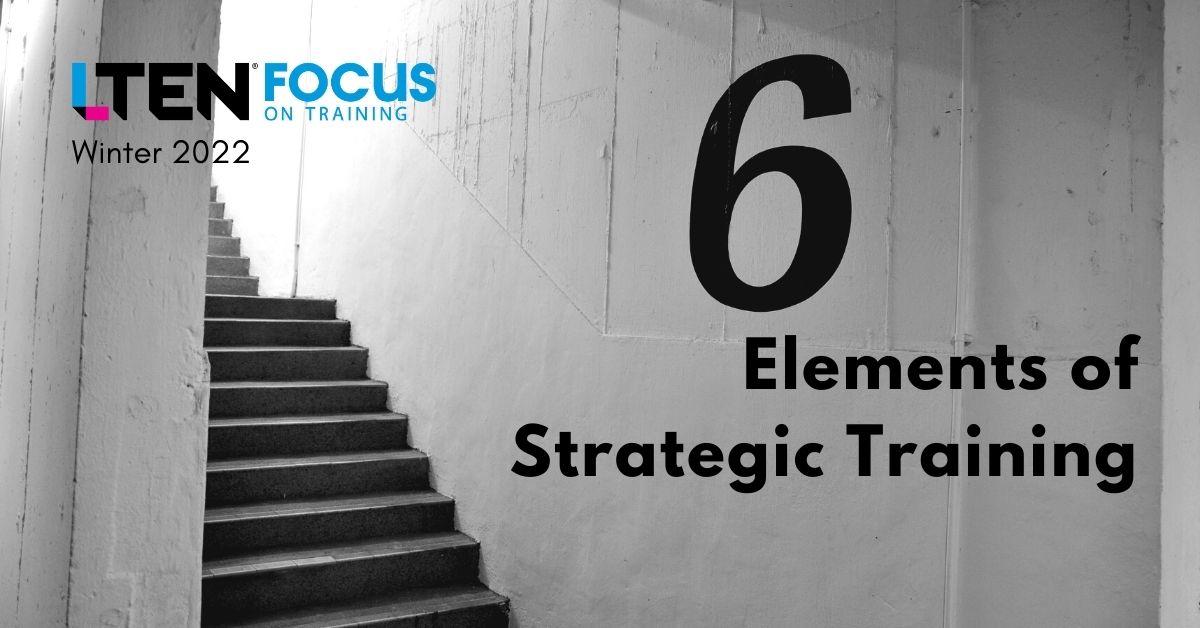
6 Elements of Strategic Training
Feature Story – By Mary Barlow
Strategic training plans ensure every action moves you closer to the goal.
 According to the Project Management Institute (PMI), companies, including those in life sciences, waste a global million dollars a second due to poor project execution. Keep in mind, this figure was released before the pandemic. PMI says a third of companies worldwide fail to gain internal alignment on strategies. Here in the United States, we waste more than a $100 million per billion dollars due to poor project performance.
According to the Project Management Institute (PMI), companies, including those in life sciences, waste a global million dollars a second due to poor project execution. Keep in mind, this figure was released before the pandemic. PMI says a third of companies worldwide fail to gain internal alignment on strategies. Here in the United States, we waste more than a $100 million per billion dollars due to poor project performance.
There’s clearly room for improvement.
With urgent product launches and other initiatives, it’s tempting to jump from training needs to tactics. However, without first establishing a strong strategic plan, you could be contributing to the million-dollars-a-second snafu. Your team can optimize educational investments by becoming more strategically mature.
Strategic training plans ensure every action moves your organization closer toward the overall objective until it’s met — without wandering or stumbling off course.
6 Elements of Strategic Training Plans
When strung together, these elements provide an executable plan with a rationale to clearly support each solution:
- The Situation
- Organizational Objectives
- Training Audience
- Strategies
- Tactics
- Timeline
Let’s run through each element and some examples based on a fictional scenario.
1. The Situation
In one to three paragraphs, provide the background or an explanation of what happened that led to the need for training. In this section, simply state the facts without jumping to solutions. Be sure to mention what’s at stake.
We anticipate that PRODUCT will be approved in August 202X. PRODUCT is a novel intramuscular injection for [indication], which is a rare disease affecting a patient’s ability to… PRODUCT must be administered by a physician in an inpatient hospital setting. The drug will be sold by an existing sales team that is not trained to engage customers in the hospital.
Account management teams will engage integrated delivery networks and large institutions. There are no other products on the market to treat this disease, but our marketing research reveals two likely competitors are currently in development.
The launch of our product is critical because…
What’s at stake is…
2. Organizational Objective
 As opposed to learning objectives, your organizational objective defines only the greater outcome you must attain. You will state learning objectives for each solution in step 5. To uncover the true overarching objective, just ask yourself “Above all else, what do we need to achieve?” The best objectives are SMART (specific, measurable, achievable, relevant and timebound). Think carefully about your objective since the success of your product hinges on its accuracy.
As opposed to learning objectives, your organizational objective defines only the greater outcome you must attain. You will state learning objectives for each solution in step 5. To uncover the true overarching objective, just ask yourself “Above all else, what do we need to achieve?” The best objectives are SMART (specific, measurable, achievable, relevant and timebound). Think carefully about your objective since the success of your product hinges on its accuracy.
The organizational objective is to execute a strong on-time launch measured by sales success within the first X months after drug approval.
3. Training Audience
Include everyone in your purview who will help meet the organizational objective, even if your budget won’t stretch to cover them all. Considering everyone early may at least help leadership weigh the value of their involvement.
Mention the types of information each audience will need to learn.
- Sales representatives (sales strategy, disease state, product, market access and competitive landscape, internal ways of working)
- Sales managers (same as sales reps, plus coaching and reinforcement)
- Key account managers (market access strategy and competitive landscape, product, disease state, internal ways of working)
- Reimbursement specialists (disease state, introductory product information, market access landscape, ways of working)
- Marketers and marketing leadership (disease state, product, market access and competitive landscape)
- Trainers (all of the above)
4. Strategies
Without moving into tactical detail, your strategies explain what you must do to achieve your objective. When drafting strategies, avoid getting bogged down with the details of your tactics. Eventually, the right strategies will guide you precisely to the right tactics or training solutions to build.
- Develop a comprehensive curriculum for each training audience.
- Train on all aspects of engaging the hospital, including authorized access, hospital departments, who to engage and what to say.
- Reinforce training for long-term uptake.
- Ensure internal alignment on all training initiatives.
- Incorporate input on this plan from all key stakeholders.
Note: Large plans may include a single major objective along with goals or project milestones under it. In such cases, each goal would have its own set of strategies.
5. Tactics
Now we’re ready for details. Tactics are specific actions and solutions to carry out each strategy — often a series of tactics is needed per strategy. Getting tactics right often requires research into the product, disease state, market, etc. To determine tactics, start by listing the steps and items needed to carry out each strategy.
- Strategy 1: Develop a comprehensive curriculum for each training audience: Tactic: Create a slide dedicated to each training audience, listing out the detailed curriculum for their roles.
- Strategy 2: Train on all aspects of engaging the hospital: Tactics for this strategy may include:
- virtual workshop on engaging the hospital
- brief recap guide
- podcast featuring a pharmacy director quick reference guide that could be used on the job in the flow of work
For each tactic, include its key points, learning objectives, media type, time
investment and so on.
6. Timeline
Your timeline plots all actions to realize your objective.
- Kickoff Training Development
- Obtain Approved Marketing
- Other Resources
- Develop Solutions
- Gain Regulatory Approval
- Begin Home Study
- Hold Launch Meeting
- Deploy Post-Launch Reinforcement Activities
Remember to gain insights from key internal stakeholders on your draft plan. With
a strategic plan, you’ll have a complete roadmap for building all training deliverables. Share your plan with leadership to communicate your training intentions—and convey that you’ve got this. Also share it with colleagues to keep them squarely focused on the right tasks.
Conclusion
There’s never been a better time for strong strategic plans. If before COVID, the world lost a million-dollars-a-second due to poor execution, how much could we lose in this extraordinary post-pandemic time?
Mary Barlow is senior director of media production at Encompass Communications and Learning. Email Mary at mbarlow@encompasscnl.com.









